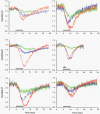Interstitial pH in human skeletal muscle during and after dynamic graded exercise
- PMID: 11744771
- PMCID: PMC2279011
- DOI: 10.1111/j.1469-7793.2001.00993.x
Interstitial pH in human skeletal muscle during and after dynamic graded exercise
Abstract
1. In this study a new method has been used to measure interstitial pH continuously in human muscle during graded exercise. Human subjects performed 5 min of one-legged knee-extensor exercise at power outputs of 30, 50 and 70 W. Muscle interstitial pH was measured continuously in microdialysis dialysate using the pH-sensitive fluorescent dye 2',7'-bis-(2-carboxyethyl)-5-(and -6)-carboxyfluorescein (BCECF). 2. The mean interstitial pH at rest was 7.38 +/- 0.02. Interstitial pH gradually reduced during exercise in a nearly linear manner. The mean value (range) of the lowest interstitial pH at 30, 50 and 70 W exercise was 7.27 (7.18-7.34), 7.16 (7.05-7.24) and 7.04 (6.93-7.12), respectively. 3. The lowest pH was obtained 1 min after exercise, irrespectively of the workload, after which interstitial pH recovered in a nearly exponential manner. The mean half-time for recovery was 5.2 min (range 4.1-6.1 min). The changes in interstitial pH exceeded the changes in venous blood pH. 4. The present study showed that interstitial pH decreased during exercise in relation to intensity. These pH changes could have implications for blood flow regulation as well as for modulations of membrane transport systems.
Figures



Similar articles
-
Interstitial K(+) in human skeletal muscle during and after dynamic graded exercise determined by microdialysis.Am J Physiol Regul Integr Comp Physiol. 2000 Feb;278(2):R400-6. doi: 10.1152/ajpregu.2000.278.2.R400. Am J Physiol Regul Integr Comp Physiol. 2000. PMID: 10666141 Clinical Trial.
-
Effects of dynamic exercise on mean blood velocity and muscle interstitial metabolite responses in humans.Am J Physiol Heart Circ Physiol. 2001 Oct;281(4):H1734-41. doi: 10.1152/ajpheart.2001.281.4.H1734. Am J Physiol Heart Circ Physiol. 2001. PMID: 11557565
-
Muscle interstitial glucose and lactate levels during dynamic exercise in humans determined by microdialysis.J Appl Physiol (1985). 1999 Oct;87(4):1483-90. doi: 10.1152/jappl.1999.87.4.1483. J Appl Physiol (1985). 1999. PMID: 10517782
-
Changes in interstitial K+ and pH during exercise: implications for blood flow regulation.Appl Physiol Nutr Metab. 2007 Oct;32(5):846-51. doi: 10.1139/H07-065. Appl Physiol Nutr Metab. 2007. PMID: 18059608 Review.
-
Microdialysis of skeletal muscle at rest.Proc Nutr Soc. 1999 Nov;58(4):919-23. doi: 10.1017/s0029665199001226. Proc Nutr Soc. 1999. PMID: 10817159 Review.
Cited by
-
The effect of local passive heating on skeletal muscle histamine concentration: implications for exercise-induced histamine release.J Appl Physiol (1985). 2022 Feb 1;132(2):367-374. doi: 10.1152/japplphysiol.00740.2021. Epub 2021 Dec 23. J Appl Physiol (1985). 2022. PMID: 34941436 Free PMC article.
-
Route, mechanism, and implications of proton import during Na+/K+ exchange by native Na+/K+-ATPase pumps.J Gen Physiol. 2014 Apr;143(4):449-64. doi: 10.1085/jgp.201311148. J Gen Physiol. 2014. PMID: 24688018 Free PMC article.
-
A neuroinflammatory model for acute fatigue during exercise.Sports Med. 2014 Nov;44(11):1479-87. doi: 10.1007/s40279-014-0232-4. Sports Med. 2014. PMID: 25164464 Review.
-
Reaming the intramedullary canal during tibial nailing does not affect in vivo intramuscular pH of the anterior tibialis.OTA Int. 2023 May 4;6(2 Suppl):e248. doi: 10.1097/OI9.0000000000000248. eCollection 2023 May. OTA Int. 2023. PMID: 37168030 Free PMC article.
-
Changes in surface EMG assessed by discrete wavelet transform during maximal isometric voluntary contractions following supramaximal cycling.Eur J Appl Physiol. 2013 Apr;113(4):895-904. doi: 10.1007/s00421-012-2499-1. Epub 2012 Sep 23. Eur J Appl Physiol. 2013. PMID: 23001683
References
-
- Aalkjær C, Peng H-L. pH and smooth muscle. Acta Physiological Scandinavica. 1997;161:557–566. - PubMed
-
- Allsop P, Cheetham M, Brooks S, Hall GM, Williams C. Continuous intramuscular pH measurements during recovery from brief, maximal exercise in man. European Journal of Applied Physiology. 1990;59:465–470. - PubMed
-
- Arnold DL, Taylor DL, Radda GK. Investigation of human mitochondrial myopathies by phosphorus magnetic resonance spectroscopy. Annals of Neurology. 1985;18:189–196. - PubMed
-
- Aukland K, Reed RK. Interstitial-lymphatic mechanisms in the control of extracellular fluid volume. Physiological Reviews. 1993;73:1–77. - PubMed
Publication types
MeSH terms
Substances
LinkOut - more resources
Full Text Sources
Medical
Miscellaneous

